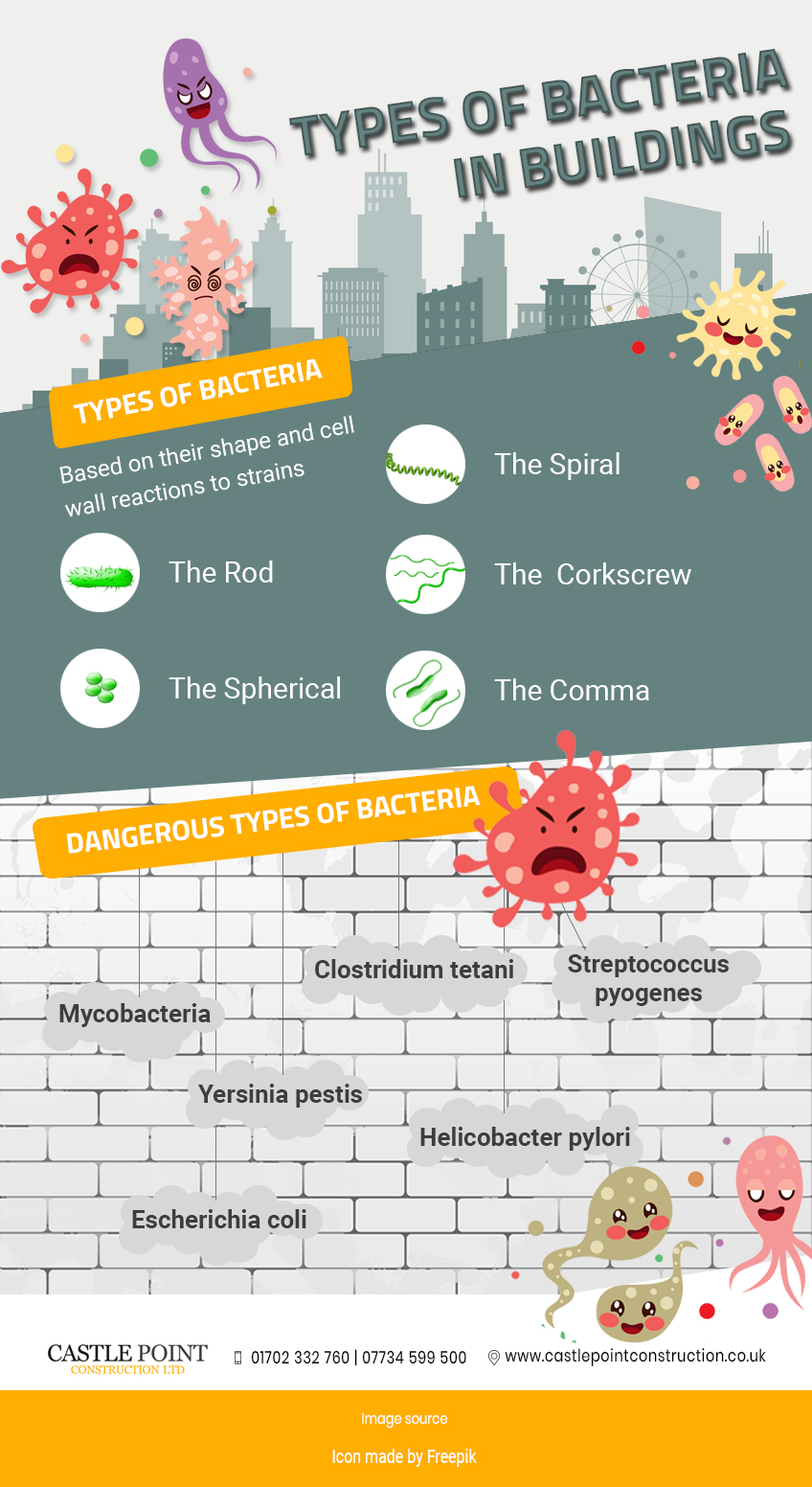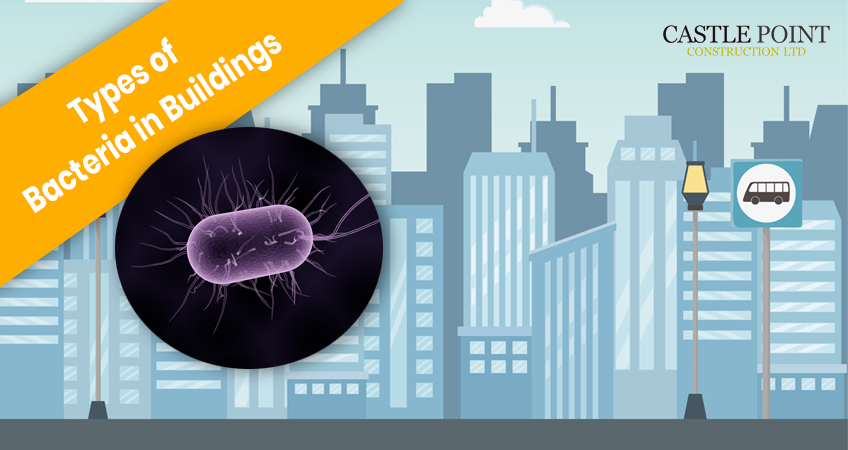Bacteria are organisms found in every home, building and office. They can survive in rocks, oceans, soil and even volcanoes. The types that are prevalent in our surrounding depend on a host of factors. Some live with other organisms, while others exist on their own. Like moulds, an increase in their level can pose threats to our health.
This article focuses on the types of bacteria in buildings and a few inspection methods you can use to spot them.
Sources of building bacteria
Most building bacteria are brought in by the occupants of the space and the outside airflow. There are also gut-associated bacteria such as clostridium, staphylococcus and lactobacillus that are common in bathrooms. Extensive research on the topic shows that the types of bacteria in a building are primarily dependent on the ventilation.
Naturally ventilated spaces have lots of soil and plant-associated bacteria. Mechanically ventilated buildings, on the other hand, allow for bacteria associated with humans.
Survival features of bacteria
With the heat and unfavourable conditions in a building, you would expect these types of bacteria to have survival features. Most of them form endospores which are resistant to chemical and physical heat, disinfectants and UV radiation. Therefore, many bacteria that produce endospores are tough to destroy.
For any type of building work – Call : 01702 332 760
The most common ones include Bacillus anthracis that causes anthrax.
Types of bacteria based on their shape and cell wall reactions to strains
There are five categories or types of bacteria based on their shape and reaction to strains;
- The Rod
- The Spiral
- The Spherical
- The Comma
- The Corkscrew
Dangerous types of bacteria
Some types of bacteria that can cause serious harm to us include;
- Mycobacteria: Mycobacteria has the shape of a rod and are gram variable, i.e., they may be either gram-negative or gram-positive. They cause lung and skin infections like tuberculosis and leprosy. In the UK, instances of infections from this bacteria are decreasing, but its antibiotic resistance has evolved ever since it was spotted in the early 90s. They can be isolated from soil, dust and water. Mycobacterium is also responsible for nosocomial outbreaks in hospital environments.
- Yersinia pestis: This is another rod-shaped bacterium found in buildings. However, unlike Mycobacteria, Yersinia pestis is gram-negative. They cause pneumonic plagues.
- Clostridium tetani: Clostridium tetani is a gram-positive, rod-shaped bacterium that affects the gastrointestinal tracts and the skin. The bacterium can cause tetanus, and when not quickly treated, death.
- Helicobacter pylori: This bacterium is associated with peptic and gastric ulcers. Many people harbour this Helicobacter pylorus, but very few show symptoms of it.
- Streptococcus pyogenes: A bacterium that often causes throat and skin infections is the streptococcus pyogenes. It causes over 700 million infections yearly and has a 25% mortality rate in severe cases. In many people, the infections from this bacterium can lead to life-threating conditions like septicaemia and shock syndrome. Luckily, infections caused by the streptococcus pyogenes can be treated using penicillin.
- Escherichia coli: Escherichia coli is a gram-negative bacillus. It causes traveller’s diarrhoea and other illnesses like meningitis. Across strains of E. coli, a high-resistance to antibiotics has been spotted. It survives easily in the digestive system of humans.
- Bacillus anthracis: It is a bacterium that occurs in animals like sheep, cattle and goat. Although occurring in these animals, Bacillus anthracis is transferrable to humans and causes abdominal problems. It is a gram-positive and rod-shaped bacterium.
- Vibrio cholerae: One of the most common bacteria in buildings and offices is Vibrio cholerae. It causes cholera and is gotten from poor sanitary or improperly cooked food.
- Salmonella typhi: Salmonella typhi is the causative bacteria of typhoid fever. It is a gram-negative bacterium that can kill if not treated quickly. Symptoms include dehydration, fever and vomiting.
- Enteritis salmonella: This bacterium causes food poisoning. Its presence can lead to life-threatening conditions like dehydration, diarrhoea and circulatory shock.
- Clostridium difficile: This is one known bacteria in the world because of its presence in many hospitals. It causes diarrhoea and complications in the colon. If the internal balance of the body has been upset, then the chances of getting C. difficile is higher.
Bacteria inspection and testing
Since bacteria are present everywhere we go to; we must know how to inspect buildings and test samples for bacteria. The inspection process should come before testing.
Types of Inspection
In looking for bacteria in buildings, the two types of inspection are;
- Rot Inspection: Rots are a significant problem in houses. Although caused by fungi, they can also be a breeding ground for different types of bacteria in homes. The real scare is that we may never notice them until they begin to harm us. Therefore, you must inspect possible contamination sites like rots within your building.
- Builder’s Inspection: There are several places where harmful bacteria are breeding in buildings that we may not even be aware of. Hence, builders need to inspect several parts of the place for traces of bacteria. This is where testing samples come into the equation because bacteria cannot be seen.
Testing for Bacteria
Food, surfaces, water, air and metalworking fluids in buildings need to be tested for bacteria to ensure a clean and hygienic environment. Samples from parts of the building are collected and taken to a lab to identify whether or not they are contaminated with bacteria.
- Gram-Staining Test: This a bacteriological test that seeks to identify the type of bacteria present in a sample from the building. A gram-negative bacterium will have traces of peptidoglycan and lipopolysaccharide. On the other hand, a gram-positive bacterium will have peptidoglycan but no lipopolysaccharide.
- Aerobic and Anaerobic Plate Count: This test is a general test used to determine the level of microorganisms in a sample. Standard Plate count, as it is also called, gives an estimate of the viable bacteria that is present in the sample being tested.
In conclusion
Buildings are not exempted sites for bacteria to inhabit. Several types of environmental and building bacteria can live and cause severe illnesses to humans. Knowing them, their symptoms and the possible threats mentioned above should help you make changes to your hygiene practices in buildings.

